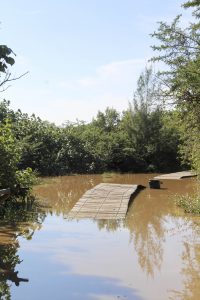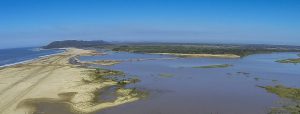As of 30 May 2017, 1.290million cubic metres of dredged soil have been moved from the Lake St Lucia estuarine system. This translates into almost 95% of the anticipated 1.363million cubic metres of dredge spoil which will be removed by early July, marking an important milestone in the process of ecological restoration for the Lake St Lucia estuarine system,” says Andrew Zaloumis, CEO of the iSimangaliso Wetland Park.
In < January 2016, iSimangaliso embarked on a R63 million project towards the restoration of the Lake St Lucia Estuary. This followed an extensive consultation process with inter alia UCOSP and scientific research concerning the health of the system and its ecological and economic importance.
The rehabilitation project comprises the removal of dredge spoil that was artificially placed in the uMfolozi River course by conservation authorities at the time, to protect the Estuary from what were believed to be damaging effects of the canalisation of the uMfolozi River and the draining of the uMfolozi floodplain for some 9100ha of sugarcane farming.
Some of the sugarcane farms lie in the tidal floodplain and are prone to backflooding – a natural estuarine process. The uMfolozi River is the powerhouse that drives the proper functioning of the estuary mouth, so the improper functioning resulted in species mortality and the collapse of prawn fisheries in the region.
Notwithstanding the extensive consultation with UCOSP (the body responsible for flood protection on the floodplain) and UCOSPs endorsement of the management plan for the Estuary, UCOSP and two farmers took iSimangaliso to the high court to compel it to breach the mouth. The application was dismissed on 21 April 2017 when Judge Mohini Moodley handed down her full judgment in the matter.
“The judgement secures this lifeline for Lake St Lucia for the greater good,” says Zaloumis. “It is still early days, but the first gains are already visible. Nature’s healing has begun.
“The area being removed was shown to be the most important portion of the dredge spoil ‘island’ to remove. Removing the eastern area of the dredge spoil will help to reinstate the hydrodynamic processes and allow a much more natural mouth dynamic to Lake St Lucia,” explains estuarine ecologist, Nicolette Forbes.
Good summer rainfall and unseasonal rains during May have also contributed to making the system more robust and is in stark contrast to the dismal state of the Lake in February last year when only 10% of the Lake’s surface area was covered by water.
From October 2016 to March 2017 approximately 870 mm of rainfall was recorded in the catchment area, including the Lake St Lucia Estuary.
[caption id="attachment_4779" align="alignleft" width="200"] Estuary high levels on May 17[/caption]The system received an additional significant supplement in excess of over 300mm between 11-16 May 2017. This contributed to a substantial increase in the water flowing in the uMfolozi River and most of the increase in water level in the Lake can be attributed to the inputs from this catchment.
Estuary high levels on May 17[/caption]The system received an additional significant supplement in excess of over 300mm between 11-16 May 2017. This contributed to a substantial increase in the water flowing in the uMfolozi River and most of the increase in water level in the Lake can be attributed to the inputs from this catchment.
The water depth is now approximately 1 – 1.2m throughout the system and salinity remains low – with freshwater conditions throughout the Estuary. Water also flowed into the lake from other catchments, such as the uMphathe and uMkhuze Rivers.
The monitoring data collected indicates the movement of water from the uMfolozi River into the Narrows and northwards to the upper lake portions. This emphasises the importance of the uMfolozi River as a water source for this estuary.
“Lake St Lucia estuary’s life blood has been returned and this puts the system in a good position as we move into the naturally dry winter months where we can expect water levels to reduce through evaporation,” concludes Zaloumis.
